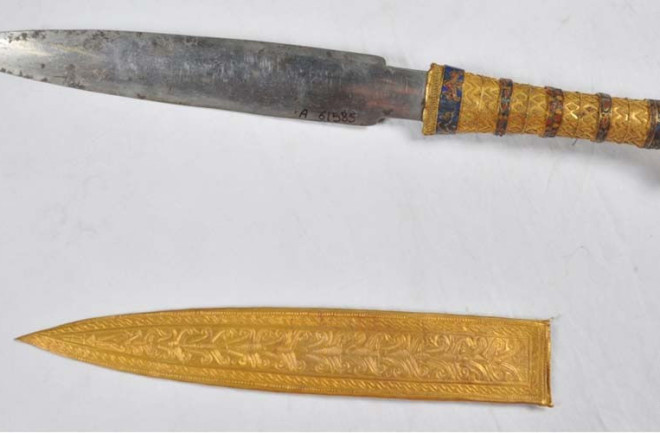King Tut took some out-of-this-world weaponry with him into the afterlife.
That’s the conclusion drawn by Italian researchers who say that an iron dagger found in his tomb was crafted from metal brought to this world by a meteorite. The knife was originally found laying across his right thigh after Howard Carter discovered the tomb in 1925, and it is housed in the Egyptian Museum in Cairo. The dagger’s composition hadn’t been studied before, because previous methods would have damaged the priceless artifact. However, with a new portable form of X-ray fluorescence spectrometry, the researchers analyzed the knife without even touching it.
Metal Composition a Clue
It was the composition of the iron that gave the knife’s origins away. Earth-based iron has a nickel concentration of around 4 percent, but King Tut’s dagger contained iron that was 11 percent nickel, which aligns with the ingredients of meteorites. What really sealed the deal was the presence of cobalt in the iron — an element largely absent from earthly metal, but relatively abundant in meteorites formed in the early days of the solar system. They published their findings last month in the journal Meteorics and Planetary Science.
“If you find a piece of native metal with nickel in it, you’ve got a flag that this might be a meteorite,” says Derek Sears, a meteoricist with NASA’s Ames Research Center who was not involved with the study. “And then if you analyze the cobalt and you find a nickel-cobalt ratio the way they do, then it’s certain it really is a meteorite.”
While Sears says that it would have been better to analyze the knife in a lab, the immense value of the artifact made that impossible. Still, he is convinced by the researchers’ findings, and stated that they went to every length possible to ensure that what they found was accurate.
Egyptians Prized Meteoric Iron
While the new insights into the dagger’s origins are intriguing, it’s actually not uncommon to find early metal artifacts with cosmic origins. Before mining was widespread, metal was in short supply and in high demand among the rich and powerful. Meteorites that were tracked as they fell were sometimes recovered and repurposed as weapons and tools — the Egyptians even had a special hieroglyphic to denote metal that fell from the heavens.
“The fact that native metal is so rare means that people have always collected these things going back to the Stone Age,” says Sears. “It’s not uncommon in the archeological world, if you find a piece of metal, for it to be meteoritic … It’s been strongly suspected that much of the metal we’ve been finding in the pyramids is meteoritic.”
This isn’t the only Egyptian artifact that fell from the skies either. As Space.com reports, nine small iron beads dating to around 3200 B.C. were discovered at a cemetery located along the Nile River.
The meteor that gifted King Tut with the raw materials for his dagger likely belonged to a fairly rare class of iron meteorites called ataxites, according to Sears. They are known for their high nickel content, and were likely once the core of an asteroid, formed when a lump of molten metal quickly cooled off.
The researchers also believe that they have pinpointed the meteorite that the dagger came from. After analyzing the composition of 20 iron meteorites found near his tomb, they isolated only one that matches the nickel levels of his dagger. Called Kharga, the meteorite weighs a little over two pounds, and was found near the northern coast of Egypt in 2000.

